ASYLUM review
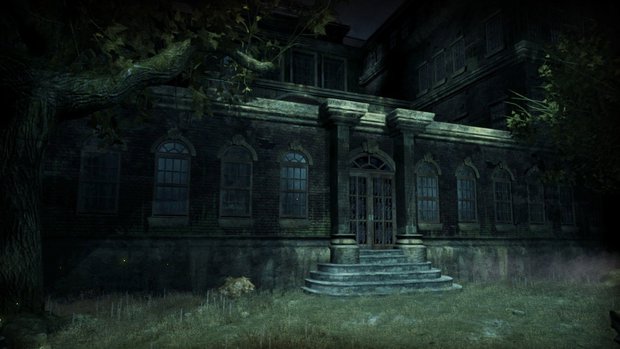
- 1 Comment
It’s crazy to think bigger is always better, as the new horror game from the creator of Scratches loses its way in a cavernous mental institution
It’s tempting to use the term “odyssey” to describe ASYLUM’s road to release, but that would be a misnomer. It only took a decade, after all, for Homer’s cunning hero to make his way home. Odysseus was an amateur; if he had the record, ASYLUM has well and truly shattered it. The game first embarked with a Kickstarter campaign in 2013, seven full years after lead designer Agustín Cordes's previous company released the point-and-click horror adventure Scratches, to widespread acclaim. An epically protracted development ensued, and it took until now, in 2025, for the game to finally come out. That makes it a full nineteen years since those of us who first explored Blackwood Manor started wondering what was next.
All this is more than simple chronology, as ASYLUM releases into a hugely different world than the one that greeted its predecessor. The games industry has weathered many seismic shifts since Scratches, and we’re all different people than we were back then. ASYLUM itself has undergone changes in engine, in structure, and—a mere week before launch!—in its main character’s voice. The question, for all involved, remains: how could it possibly live up to the hype?
Well. The answer, as it was perhaps doomed to be, is: it can’t. But it’s certainly not for lack of trying.
To its credit, ASYLUM looks, feels, and plays like exactly what it is: the follow-up to a first-person, node-based horror game released in the late 2000s. That’s by design, as Senscape’s mission from the beginning was never to reinvent the wheel but to deliver what felt like a logical, post-Scratches next step. By that metric, at least, it succeeds. It’s very much like something we might have played in 2009, warts and all. That’s a feature, not a bug.
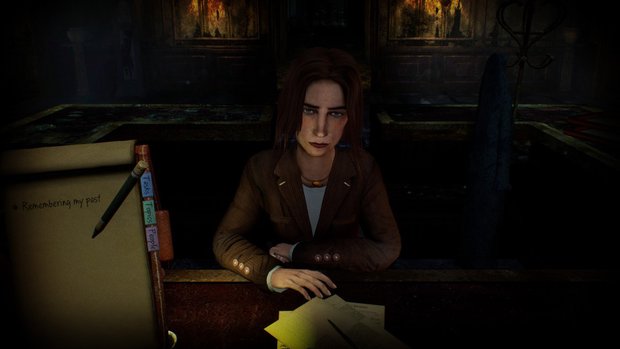
Unfortunately, ASYLUM’s fatal flaw is foundational, and no amount of retooling, extra development time, or returns to the drawing board could have corrected it: a sprawling, four-storey, and above all vacant asylum is simply too vast and empty a setting to sustain an intimate, personal tale about a small group of mostly absent characters. There’s just more real estate than a narrative like this can fill, and the result is a laborious trek back and forth through an achingly long series of dark, quiet and essentially empty rooms in search of those few locations where something is actually happening.
The game begins as the unnamed protagonist (credited as the Visitor) drives toward the abandoned Hanwell Mental Institute, where he was once a patient. Though discharged years ago, he’s lately been plagued by flashbacks, hallucinations, and bad dreams, and he hopes a return to the scene might unlock repressed memories from his time there. He recalls being part of a small group of patients, Group E, and that something terrible happened to them…but what? Try as he might, he can’t remember, and despite whatever treatment he may have received since then, he knows his psyche is still fractured. Midway through the drive, for instance, he has a vision of a dead woman in his passenger seat, who asks why he’s chosen to return before abruptly vanishing. Doing his best to ignore her, he makes his way inside.
Much to his surprise, the place isn’t as deserted as he’d expected. There’s a receptionist named Julia at the front desk, who explains that the building is under new ownership and about to reopen. It’s clear from even a cursory look at the decaying architecture that there’s still a great deal of renovation to be done, but that’s due to begin the following day. This will complicate the Visitor's search, of course, but more disturbing is what the receptionist tells him next: despite the building’s visible decrepitude, overcrowding at other facilities means some former patients have already been transferred back. With only a single security guard on staff, anyone who wants to explore the grounds does so at their own risk. Off-balance, uneasy, and unsure of his own sanity, the Visitor makes his way deeper into Hanwell, hoping to find the truth of what happened to him and the patients of Group E.
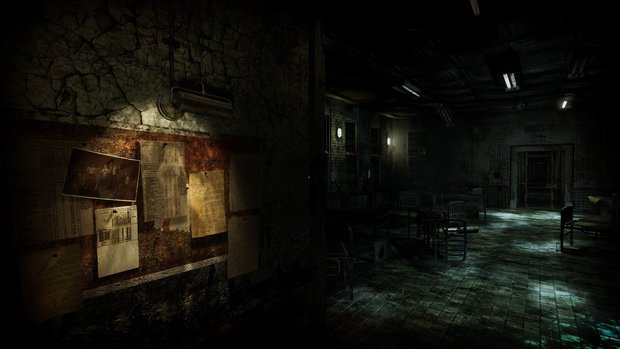
The controls will be familiar to anyone who played Scratches or its contemporaries. You move the Visitor from node to node by clicking where the movement cursor appears; in each node you can turn and look around you with full 360-degree range of motion. A magnifying glass appears over hotspots you can examine, and a grasping hand over the ones you can take or manipulate. A wrench icon over a hotspot indicates you can use your inventory there; a right click brings an item out, with the mouse wheel to scroll through the objects you’ve collected and a left click to use the one you’ve chosen. This helps to cut down on tedious “try everything everywhere” situations; if there’s no wrench, there’s no need to consider what you’re carrying.
That’s about the only mitigating factor for tedium, though, as the game’s biggest problem is evident early on. Even with only a single floor open to you, Hanwell is just too damn big and too damn barren to sustain a game whose core mechanics are item collection, conversation, and screen-by-screen exploration. The great majority of the ten or so hours you spend there consist of long, back-and-forth journeys from one place to another with nothing but moldy wallpaper and busted furniture to look at along the way. Once you’ve gotten where you were going and done what you needed there, it’s time to turn back around and do it all again in another direction.
Too often you’ll find a clue or item needed to bypass the next obstacle—usually a locked door—and wind up trekking across anywhere from fifteen to forty screens to get back to where you can use it. Accessing a new floor only compounds the problem, with each adding anywhere from fifty to a hundred more nodes to traverse. By the end of the game you’re zigzagging hither and yon, connecting dots spread across four main levels, a basement, and a sewer, with nothing to disrupt the monotony and no fast travel to speed things up.
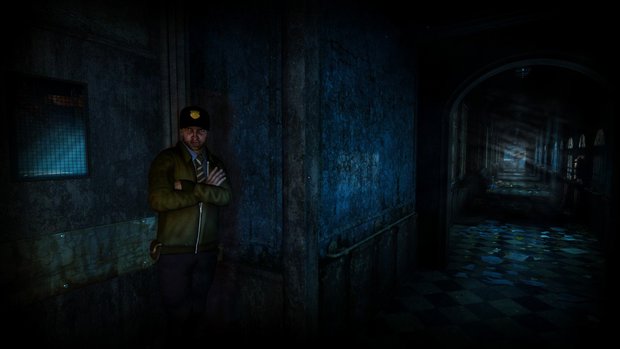
At the very least, ASYLUM tries to make sure you know what you should be doing. The Visitor carries a notebook with him that serves, via four separate tabs, as a combination quest log, character database, dialogue menu, and inventory list. You can take the notebook out at any time with a right click and select a topic to get the Visitor’s thoughts; in conversation he’ll produce it automatically, where it does double duty as a dialogue menu. As you learn more about the Institute, you’re free to return to characters you’ve met and ask about new discoveries—though, once again illustrating the vast gulf between space and substance, there are only four people in the entire building you can actually talk to.
The notebook mechanic is straightforward enough, but the conversation system is awkwardly implemented and poorly optimized. There’s no way to know when you’ve exhausted everything a character has to say on a given topic except by clicking, which eventually leads either to a repeat of your previous exchange or to the Visitor proclaiming aloud that he has nothing left to say on the subject and the other speaker commenting on his comment. On its own this would be a nuisance; the bigger problem is that, considered alongside the rest of the dialogue, the halting awkwardness barely stands out.
The writing in ASYLUM is, quite frankly, tin-eared, and characters constantly engage in clunky, odd-sounding exchanges. There’s nothing so out of place that the meaning gets lost, but it’s hard to ignore how stilted and unnatural it feels, especially when spoken aloud. Though every voiced character save one is, ostensibly, a native English speaker, they struggle with its nuances: a security guard dismisses a question as being “above my paycheck,” the vanished Dr. Hanwell is described redundantly as the former “head director,” an irritable character requests to be left alone and the Visitor replies with “Why such intolerance?” It’s all comprehensible, but it makes it harder to buy into the game’s conception of who these characters are, and leaves the script feeling like it needed another pass at localization.
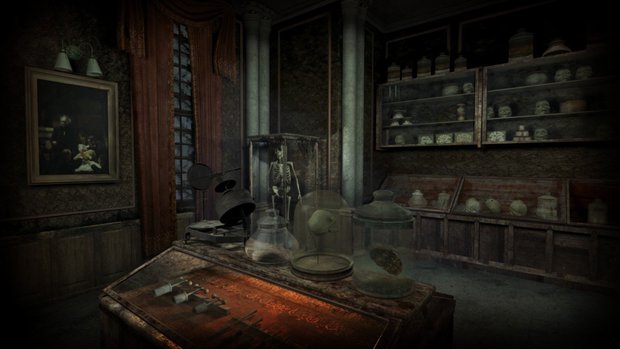
This further distances the player from the story and characters, and considering how much of it is already given over to empty, lifeless spaces, ASYLUM can ill afford that. The in-game character models are surprisingly detailed, especially considering the less-than-convincing equivalents in most cutscenes, but their speaking animations are stiff, with speech only affecting the lower halves of their faces. The voice cast does its best with the script, but most are fighting a losing battle. The sole standout is Dark Fall developer Jonathan Boakes as Dr. Miller, the new head of the Institute, whose performance evokes the late David Warner so thoroughly that I wondered for a moment if Senscape had gotten the latter into the recording studio before his passing.
Unfortunately, it’s a brief appearance; Dr. Miller disappears midway through the game without any explanation, and is never mentioned again. I thought at first that the game might be doing something clever with the Visitor’s penchant for hallucinations, but characters who are unquestionably real come and go just as abruptly, with even less reason to abandon their posts. It’s just one more way that the setting and story fail to mesh and derail what the game is trying to do.
Senscape has proudly invoked Scratches as a comparison point for ASYLUM’s narrative, and in some ways it’s not far off. There, too, the cast was small, with much of the story set in a far-off past which the protagonist had to uncover. A crucial difference, though, is that Scratches was centered on a single family’s home, and everything we saw was part of the life they’d built there. It was an environment created, inhabited, and defined entirely by the Blackwoods, with each piece communicating some part of their history by its very presence. The family was gone, yes, but what they’d left behind imbued the setting with character, personality, and a line of continuity stretching into history. That was enough to keep us exploring all the way from the attic to the (very memorable) basement.
Here, Group E consisted of fewer than ten patients, with only three staff members apparently involved in their treatment. Hanwell, we’re told, once held close to three hundred inmates, and the parts of it we traverse were open to all. Most of them, though, are never described, named, or even mentioned, and it’s hard to be disturbed by what they might have endured when the game doesn’t treat them like they’re worth thinking about. Despite the vastness of the building, the notes and journal entries we find are invariably about Group E. We find few traces of the others who spent time there, or even the ones currently on-site. Visually, then, most of the areas we move through are impersonal spaces, conveying little of import about the characters we’re meant to care for, even while the documents we recover treat them as the only residents who mattered.
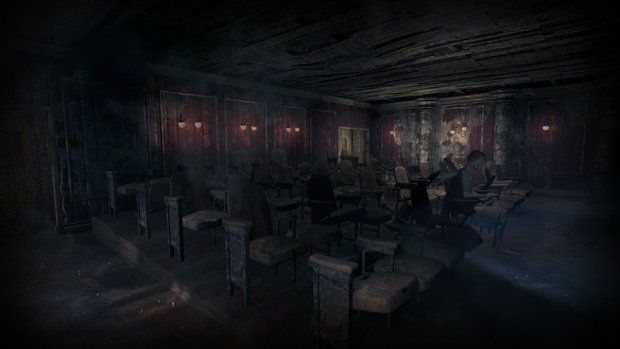
We explore cell blocks, surgical wings, living spaces, and institutional departments, and though many residents, staff members, and visitors have passed through over the years, we get no sense or feeling for any except the few with direct relevance to our character’s story. The Institute never comes to feel like a place we can care about or connect with. It’s a big, empty soundstage, meant to look like a mental institution but not to feel like one, and the game isn’t equipped to make all the ground we cover seem relevant, necessary, or interesting. There’s just not a lot to actually do here.
And yet it’s not hard to see how the story could have worked if presented differently. The longer I played, and the more I discerned the contours of the Visitor’s tale, the more I wished I could have encountered it in some other form. There are interesting ideas here, with a novel and compellingly ambiguous approach to the central mystery, and I couldn’t help but feel as I wandered the corridors that it all might have worked better on film. So many of ASYLUM’s points of reference are filmic, and while there are puzzles, they’re mostly for opening doors and accessing new areas. Few feel organic, and they often serve only to pad out the play time and force us to backtrack in search of another key. At times they even detract actively from the narrative’s impact.
The game’s final locked door, for instance, is inside a room you enter early on. When the time comes to finally open it, all that’s required turns out to be something one might easily find in a building undergoing renovations, but which the game didn’t let you find until it was time. As a story development it’s ludicrous: if the Visitor has wanted to get through there since the beginning, and doing so is this easy, why wouldn’t he immediately start looking for the means to that end? There’s no reason, except that the developers didn’t want him to yet. Thus we get one of several puzzles that seem to be there just for the sake of having them, and which feel at odds with what we understand of the story.
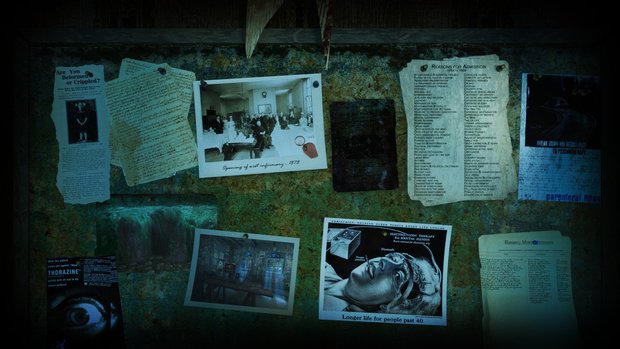
For all that ASYLUM seems to exist uncomfortably in an interactive medium, it never makes much effort to embrace it, either. Take the way the Visitor’s hallucinations are established in the opening moments: from a storytelling perspective it’s a canny choice, planting the gnawing question in your mind of whether you can trust what you’re seeing. Where gameplay’s concerned, though, almost nothing is done with it. The game may bill itself as “a chilling journey into the darkest depths of your mind,” but there’s little effort toward making you feel your character’s condition while you peer out through his eyes, with most of the “visions” you’ll experience consisting of brief cutscenes depicting flashbacks to the Visitor’s past. The imagined corpse-woman of the intro sequence never appears again and, save for a single startling apparition, neither does anything similar.
To be sure, it’s an aesthetic choice for the game to center the Institute’s ominous atmosphere and troubling history as its primary source of horror, rather than a spook show gallery of macabre phantasms. The problem isn’t that it fails to use the Visitor’s unstable grip on reality to scare you, but that such a significant aspect of the protagonist’s reality is never integrated into the player’s. The Visitor’s most tangible hallucinations—his flashbacks—exist mostly to move the plot along, letting him remember something he should investigate in the present. As products of his psyche they give us little insight into his character, and few of the people they show us ever develop into more than a face or a name. We’re told, repeatedly, that the Visitor is a man on the brink of sanity, but after spending so long in his head we never feel that way ourselves.
There’s a similar disconnect between the horror ASYLUM wants us to find in the Hanwell Mental Institute as a setting and the steps it takes to actually instill it. It’s not, of course, a pleasant place: look one way and you’ll see a musty, water-stained hallway piled with decayed and rusting machinery; look another and find your path blocked by heaped rubbish and soiled, insect-ridden linens. Everywhere it’s dark and dim, the only bright colors coming from the reds of emergency lights and the greens of stagnant water. The sobs, screams, and whispered mantras of the patients in their cells echo throughout the building, and to turn a corner is to risk coming face to face with any number of grim sights: a museum of abnormal anatomy, for instance, or discarded surgical equipment covered in mysterious stains. The synth score is dark and brooding, heavy on piano and strings, and it follows us no matter where we turn.
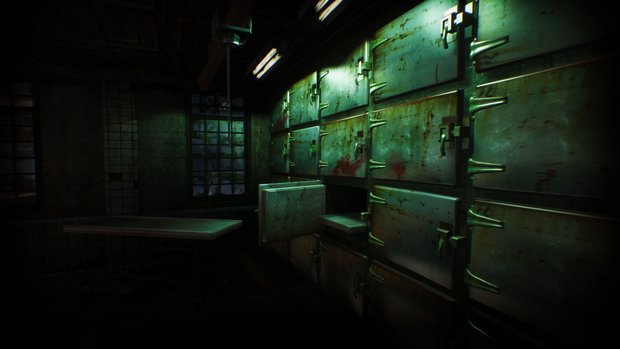
And yet it’s all so incredibly expected. H.P. Lovecraft famously wrote that “the oldest and strongest kind of fear is fear of the unknown,” but there’s precious little in ASYLUM that we haven’t seen in a hundred places before. One will recognize bits and pieces from such classics of medical horror and the “old dark asylum” genre as Session 9, House on Haunted Hill, and Jacob’s Ladder; from mental ward dramas like Shock Corridor and psychological thrillers like The Night of the Hunter; from hospital-set games like Zork Nemesis and the Silent Hill series; and, of course, from Lovecraft himself, whose influence hangs more heavily over Hanwell than all of its many cobwebs. Horror has always been a self-referential genre, with successive generations iterating on and remixing what came before, but to do it well requires building something new and unexpected on that foundation; too often, ASYLUM just shows us the familiar and hopes it will be enough.
Even the game’s attempts at sudden, shocking gore or brutal violence fail to land with much weight. I’m not opposed to blood and guts by any means—I watched Cannibal Holocaust while eating a turkey drumstick—but it’s an approach to horror that requires discernment, discretion, and aesthetic flair to pull off, and ASYLUM simply hasn’t got those where it counts. Firstly, many of these moments occur in flashbacks, meaning the characters involved are ones that we as players don’t actually know. Secondly, the brief, seconds-long cinematics leave them feeling so thinly sketched and devoid of personality that the carnage has little emotional heft. This, along with the cutscenes’ unconvincing character models, leaves us feeling like we’re watching lifeless puppets who exist for the sole purpose of facilitating an outré moment. (And the less said about the tasteless way it uses a character institutionalized after surviving a rape, the better.) There are a few exceptions—an extended autopsy sequence is, ironically, one of the few moments where the game feels totally alive—but they can’t carry the slack on their own.
It’s all especially disappointing in a successor to Scratches, whose keen understanding of how interactive horror works is still celebrated almost two decades later. One of that game’s greatest strengths lay in the sense of imminent danger it instilled in the player, neatly obscuring the fact that your character couldn’t actually die. It achieved this in part by dint of a sudden unexpected moment early on that made you feel, for just a moment, as if you’d come face to face with death, and you spent the rest of your stay in Blackwood Manor wondering if the next time might be the real thing. The threat felt real, and the game never telegraphed how far it might allow itself to go.
ASYLUM, on the other hand, never establishes a comparable illusion. Potential “threats,” like the agitated patients you sometimes glimpse through cell doors, never feel like real parts of your world. The pre-rendered, endlessly repetitive nature of their animation loops is always obvious, making them seem like mere set dressing, and any sense of realism is shattered by the way they sometimes glitch out, freeze, or fail to trigger at all. The result is that you spend the game acutely aware that, spooky atmosphere aside, what you’re really doing is playing a low-stress, danger-free point-and-clicker. By the time the game embroils you in a cat-and-mouse chase, it’s far too obvious that your pursuer can’t actually catch you—no matter how much they rattle and bang on the other side of doors we’ve seen to be demonstrably unlocked.
Final Verdict
None of this, I will stress, feels like the result of laziness or half-assed get-it-out-the-door-ism on Senscape’s part. For better and worse, this is the game the developers set out to make those many years ago, and its release after so long is a testament to their resilience and tenacity. There’s no doubt that ASYLUM is a labor of love; there’s too much affection for and knowledge of the horror genre on display for it to have been anything else. Still, love and respect for the genre aren’t enough to completely save this game from the emptiness of its setting, or from the fatal disconnect between its narrative ambitions and its interactive nature. Despite bright spots here and there, it just isn’t a very satisfying, engaging, or entertaining game overall, and little about it is likely to persist in the memory beyond the lessons to be learned from it. Either way, the story of ASYLUM has finally ended, and those who waited down the years to see it through can go back to wondering, as we once did, about what comes next. Whatever it may be, I hope it surprises us.
Hot take
It’s nice to finally have ASYLUM in our hands after so long, but while it has the makings of an interesting story at its center, the vast size and emptiness of its namesake hospital overwhelm everything else about it, and it never gets a handle on how to balance narrative and gameplay or to deliver the horror it promises.
Pros
- Contains the framework of an interesting psychological horror story
- Made with clear love and reverence for the horror genre
- Atmospheric score
Cons
- Sprawling setting is so big and empty that most of your time is spent on tedious backtracking
- Puzzles feel artificial and disconnected from the story
- Subpar dialogue writing makes the characters hard to connect to
- Attempts at horror are derivative, further compromised by unsatisfying production values and poor design choices
Will played ASYLUM on PC using a review code provided by the game's publisher.


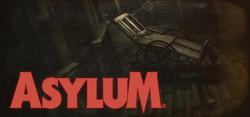
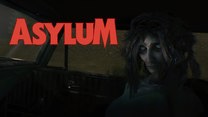







1 Comment
Want to join the discussion? Leave a comment as guest, sign in or register.
Looks like Asylum delivers a thrilling and chilling experience that taps into deep fears. For readers interested in how real-world asylums operated long ago—with true stories of abuse and neglect—Asylum Scandals brings those historical realities to light.
Reply
Leave a comment